Unit 5: Management Accounting Report for Connect Catering Services
VerifiedAdded on 2022/12/22
|16
|4746
|78
Report
AI Summary
This report delves into the realm of management accounting, focusing on its application within Connect Catering Services (CCS). It begins by explaining different types of management accounting, such as cost accounting systems, price optimization, job costing systems, and inventory management systems, highlighting their benefits and drawbacks. The report then examines various methods used for management accounting reports, including account receivable aging, cost managerial accounting, performance reports, and budget reports. Furthermore, the report provides detailed calculations of costs, including marginal costing, absorption costing, and a reconciliation statement. It also explores fixed and variable costs, margin of safety, break-even point analysis, break-even graphs, and variance analysis. The report then evaluates the advantages and disadvantages of different planning tools used for budgetary control and discusses the use of management accounting systems to respond to financial problems, culminating in a conclusion and references.
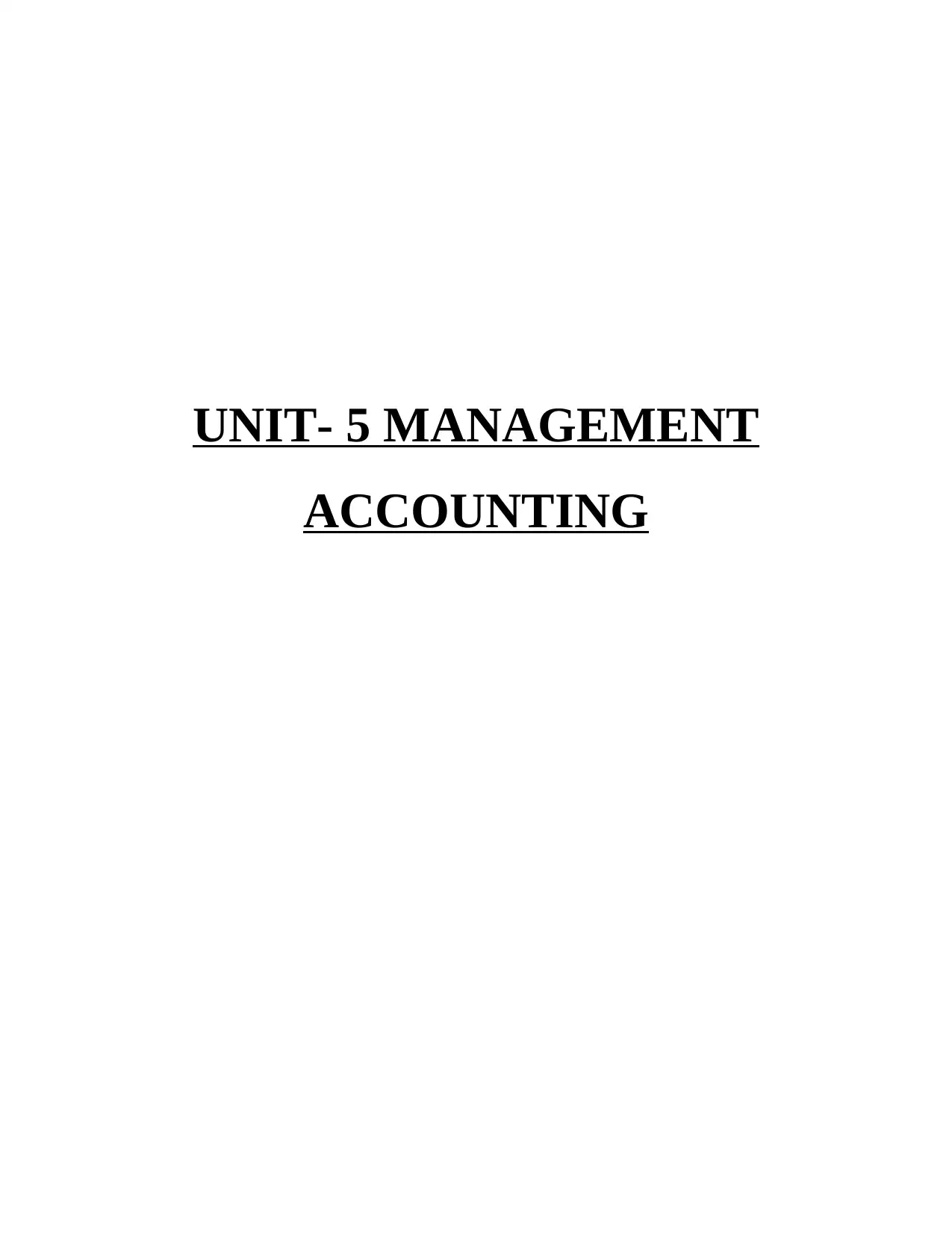
UNIT- 5 MANAGEMENT
ACCOUNTING
ACCOUNTING
Paraphrase This Document
Need a fresh take? Get an instant paraphrase of this document with our AI Paraphraser
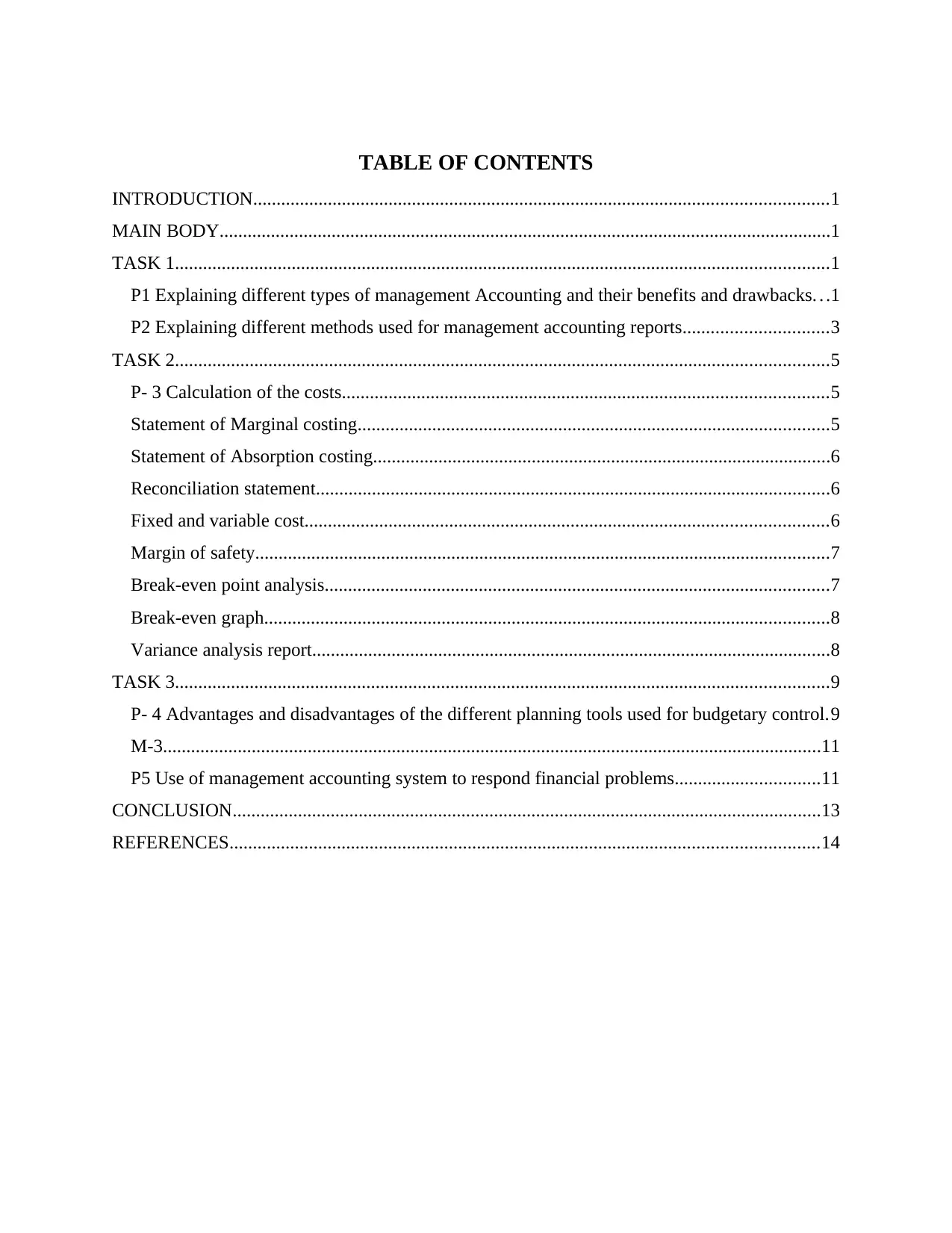
TABLE OF CONTENTS
INTRODUCTION...........................................................................................................................1
MAIN BODY...................................................................................................................................1
TASK 1............................................................................................................................................1
P1 Explaining different types of management Accounting and their benefits and drawbacks. . .1
P2 Explaining different methods used for management accounting reports...............................3
TASK 2............................................................................................................................................5
P- 3 Calculation of the costs........................................................................................................5
Statement of Marginal costing.....................................................................................................5
Statement of Absorption costing..................................................................................................6
Reconciliation statement..............................................................................................................6
Fixed and variable cost................................................................................................................6
Margin of safety...........................................................................................................................7
Break-even point analysis............................................................................................................7
Break-even graph.........................................................................................................................8
Variance analysis report...............................................................................................................8
TASK 3............................................................................................................................................9
P- 4 Advantages and disadvantages of the different planning tools used for budgetary control.9
M-3.............................................................................................................................................11
P5 Use of management accounting system to respond financial problems...............................11
CONCLUSION..............................................................................................................................13
REFERENCES..............................................................................................................................14
INTRODUCTION...........................................................................................................................1
MAIN BODY...................................................................................................................................1
TASK 1............................................................................................................................................1
P1 Explaining different types of management Accounting and their benefits and drawbacks. . .1
P2 Explaining different methods used for management accounting reports...............................3
TASK 2............................................................................................................................................5
P- 3 Calculation of the costs........................................................................................................5
Statement of Marginal costing.....................................................................................................5
Statement of Absorption costing..................................................................................................6
Reconciliation statement..............................................................................................................6
Fixed and variable cost................................................................................................................6
Margin of safety...........................................................................................................................7
Break-even point analysis............................................................................................................7
Break-even graph.........................................................................................................................8
Variance analysis report...............................................................................................................8
TASK 3............................................................................................................................................9
P- 4 Advantages and disadvantages of the different planning tools used for budgetary control.9
M-3.............................................................................................................................................11
P5 Use of management accounting system to respond financial problems...............................11
CONCLUSION..............................................................................................................................13
REFERENCES..............................................................................................................................14
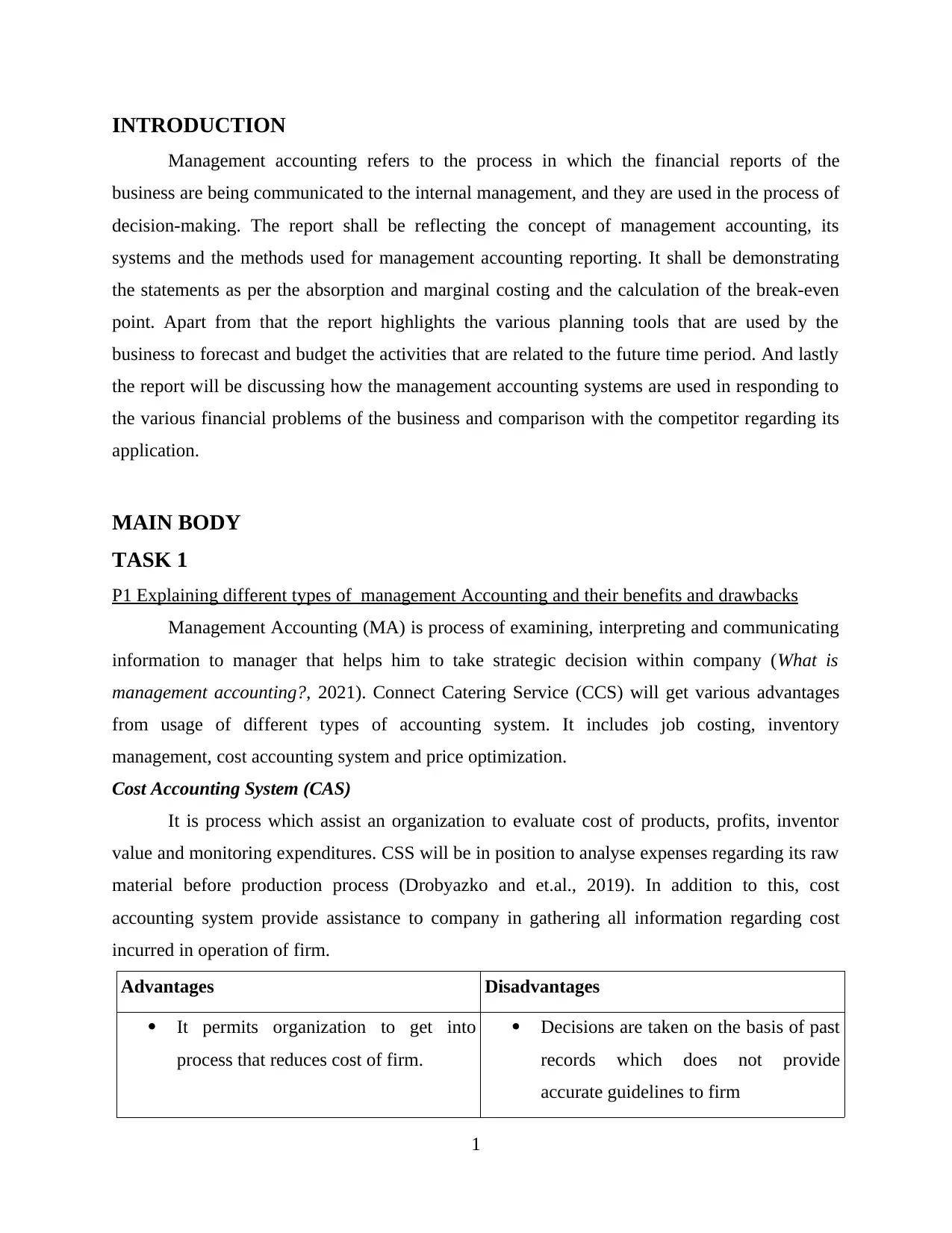
INTRODUCTION
Management accounting refers to the process in which the financial reports of the
business are being communicated to the internal management, and they are used in the process of
decision-making. The report shall be reflecting the concept of management accounting, its
systems and the methods used for management accounting reporting. It shall be demonstrating
the statements as per the absorption and marginal costing and the calculation of the break-even
point. Apart from that the report highlights the various planning tools that are used by the
business to forecast and budget the activities that are related to the future time period. And lastly
the report will be discussing how the management accounting systems are used in responding to
the various financial problems of the business and comparison with the competitor regarding its
application.
MAIN BODY
TASK 1
P1 Explaining different types of management Accounting and their benefits and drawbacks
Management Accounting (MA) is process of examining, interpreting and communicating
information to manager that helps him to take strategic decision within company (What is
management accounting?, 2021). Connect Catering Service (CCS) will get various advantages
from usage of different types of accounting system. It includes job costing, inventory
management, cost accounting system and price optimization.
Cost Accounting System (CAS)
It is process which assist an organization to evaluate cost of products, profits, inventor
value and monitoring expenditures. CSS will be in position to analyse expenses regarding its raw
material before production process (Drobyazko and et.al., 2019). In addition to this, cost
accounting system provide assistance to company in gathering all information regarding cost
incurred in operation of firm.
Advantages Disadvantages
It permits organization to get into
process that reduces cost of firm.
Decisions are taken on the basis of past
records which does not provide
accurate guidelines to firm
1
Management accounting refers to the process in which the financial reports of the
business are being communicated to the internal management, and they are used in the process of
decision-making. The report shall be reflecting the concept of management accounting, its
systems and the methods used for management accounting reporting. It shall be demonstrating
the statements as per the absorption and marginal costing and the calculation of the break-even
point. Apart from that the report highlights the various planning tools that are used by the
business to forecast and budget the activities that are related to the future time period. And lastly
the report will be discussing how the management accounting systems are used in responding to
the various financial problems of the business and comparison with the competitor regarding its
application.
MAIN BODY
TASK 1
P1 Explaining different types of management Accounting and their benefits and drawbacks
Management Accounting (MA) is process of examining, interpreting and communicating
information to manager that helps him to take strategic decision within company (What is
management accounting?, 2021). Connect Catering Service (CCS) will get various advantages
from usage of different types of accounting system. It includes job costing, inventory
management, cost accounting system and price optimization.
Cost Accounting System (CAS)
It is process which assist an organization to evaluate cost of products, profits, inventor
value and monitoring expenditures. CSS will be in position to analyse expenses regarding its raw
material before production process (Drobyazko and et.al., 2019). In addition to this, cost
accounting system provide assistance to company in gathering all information regarding cost
incurred in operation of firm.
Advantages Disadvantages
It permits organization to get into
process that reduces cost of firm.
Decisions are taken on the basis of past
records which does not provide
accurate guidelines to firm
1
⊘ This is a preview!⊘
Do you want full access?
Subscribe today to unlock all pages.

Trusted by 1+ million students worldwide
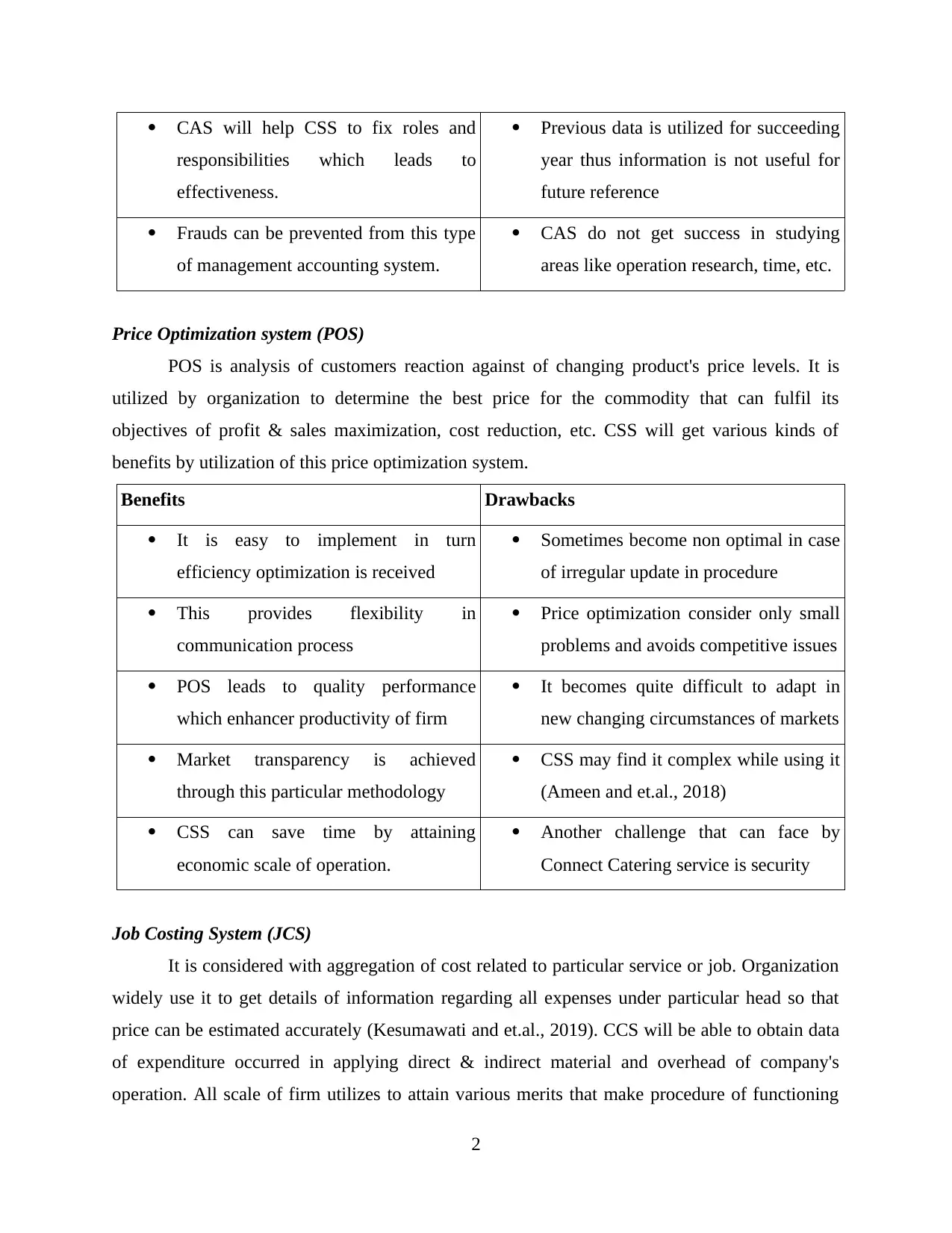
CAS will help CSS to fix roles and
responsibilities which leads to
effectiveness.
Previous data is utilized for succeeding
year thus information is not useful for
future reference
Frauds can be prevented from this type
of management accounting system.
CAS do not get success in studying
areas like operation research, time, etc.
Price Optimization system (POS)
POS is analysis of customers reaction against of changing product's price levels. It is
utilized by organization to determine the best price for the commodity that can fulfil its
objectives of profit & sales maximization, cost reduction, etc. CSS will get various kinds of
benefits by utilization of this price optimization system.
Benefits Drawbacks
It is easy to implement in turn
efficiency optimization is received
Sometimes become non optimal in case
of irregular update in procedure
This provides flexibility in
communication process
Price optimization consider only small
problems and avoids competitive issues
POS leads to quality performance
which enhancer productivity of firm
It becomes quite difficult to adapt in
new changing circumstances of markets
Market transparency is achieved
through this particular methodology
CSS may find it complex while using it
(Ameen and et.al., 2018)
CSS can save time by attaining
economic scale of operation.
Another challenge that can face by
Connect Catering service is security
Job Costing System (JCS)
It is considered with aggregation of cost related to particular service or job. Organization
widely use it to get details of information regarding all expenses under particular head so that
price can be estimated accurately (Kesumawati and et.al., 2019). CCS will be able to obtain data
of expenditure occurred in applying direct & indirect material and overhead of company's
operation. All scale of firm utilizes to attain various merits that make procedure of functioning
2
responsibilities which leads to
effectiveness.
Previous data is utilized for succeeding
year thus information is not useful for
future reference
Frauds can be prevented from this type
of management accounting system.
CAS do not get success in studying
areas like operation research, time, etc.
Price Optimization system (POS)
POS is analysis of customers reaction against of changing product's price levels. It is
utilized by organization to determine the best price for the commodity that can fulfil its
objectives of profit & sales maximization, cost reduction, etc. CSS will get various kinds of
benefits by utilization of this price optimization system.
Benefits Drawbacks
It is easy to implement in turn
efficiency optimization is received
Sometimes become non optimal in case
of irregular update in procedure
This provides flexibility in
communication process
Price optimization consider only small
problems and avoids competitive issues
POS leads to quality performance
which enhancer productivity of firm
It becomes quite difficult to adapt in
new changing circumstances of markets
Market transparency is achieved
through this particular methodology
CSS may find it complex while using it
(Ameen and et.al., 2018)
CSS can save time by attaining
economic scale of operation.
Another challenge that can face by
Connect Catering service is security
Job Costing System (JCS)
It is considered with aggregation of cost related to particular service or job. Organization
widely use it to get details of information regarding all expenses under particular head so that
price can be estimated accurately (Kesumawati and et.al., 2019). CCS will be able to obtain data
of expenditure occurred in applying direct & indirect material and overhead of company's
operation. All scale of firm utilizes to attain various merits that make procedure of functioning
2
Paraphrase This Document
Need a fresh take? Get an instant paraphrase of this document with our AI Paraphraser
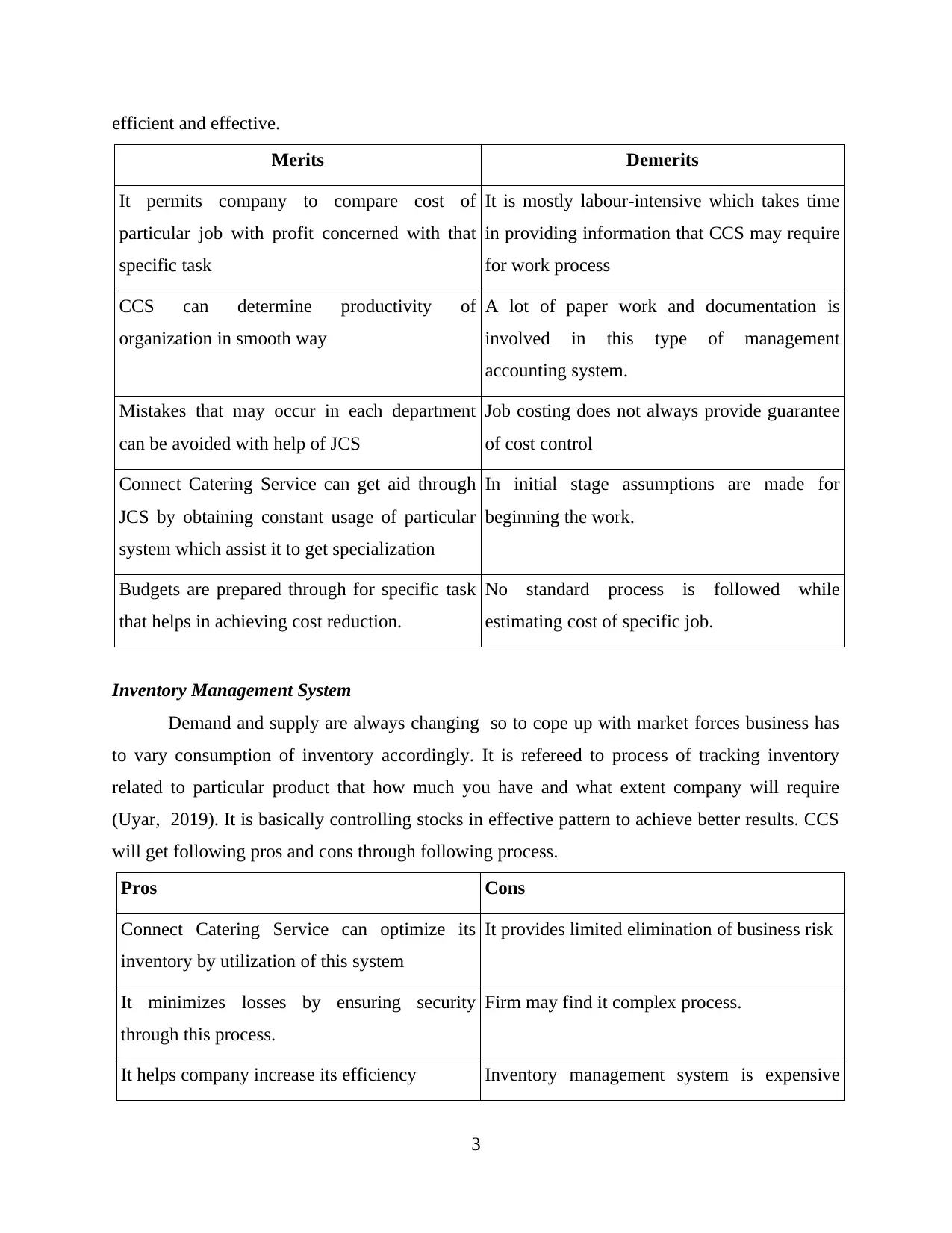
efficient and effective.
Merits Demerits
It permits company to compare cost of
particular job with profit concerned with that
specific task
It is mostly labour-intensive which takes time
in providing information that CCS may require
for work process
CCS can determine productivity of
organization in smooth way
A lot of paper work and documentation is
involved in this type of management
accounting system.
Mistakes that may occur in each department
can be avoided with help of JCS
Job costing does not always provide guarantee
of cost control
Connect Catering Service can get aid through
JCS by obtaining constant usage of particular
system which assist it to get specialization
In initial stage assumptions are made for
beginning the work.
Budgets are prepared through for specific task
that helps in achieving cost reduction.
No standard process is followed while
estimating cost of specific job.
Inventory Management System
Demand and supply are always changing so to cope up with market forces business has
to vary consumption of inventory accordingly. It is refereed to process of tracking inventory
related to particular product that how much you have and what extent company will require
(Uyar, 2019). It is basically controlling stocks in effective pattern to achieve better results. CCS
will get following pros and cons through following process.
Pros Cons
Connect Catering Service can optimize its
inventory by utilization of this system
It provides limited elimination of business risk
It minimizes losses by ensuring security
through this process.
Firm may find it complex process.
It helps company increase its efficiency Inventory management system is expensive
3
Merits Demerits
It permits company to compare cost of
particular job with profit concerned with that
specific task
It is mostly labour-intensive which takes time
in providing information that CCS may require
for work process
CCS can determine productivity of
organization in smooth way
A lot of paper work and documentation is
involved in this type of management
accounting system.
Mistakes that may occur in each department
can be avoided with help of JCS
Job costing does not always provide guarantee
of cost control
Connect Catering Service can get aid through
JCS by obtaining constant usage of particular
system which assist it to get specialization
In initial stage assumptions are made for
beginning the work.
Budgets are prepared through for specific task
that helps in achieving cost reduction.
No standard process is followed while
estimating cost of specific job.
Inventory Management System
Demand and supply are always changing so to cope up with market forces business has
to vary consumption of inventory accordingly. It is refereed to process of tracking inventory
related to particular product that how much you have and what extent company will require
(Uyar, 2019). It is basically controlling stocks in effective pattern to achieve better results. CCS
will get following pros and cons through following process.
Pros Cons
Connect Catering Service can optimize its
inventory by utilization of this system
It provides limited elimination of business risk
It minimizes losses by ensuring security
through this process.
Firm may find it complex process.
It helps company increase its efficiency Inventory management system is expensive
3
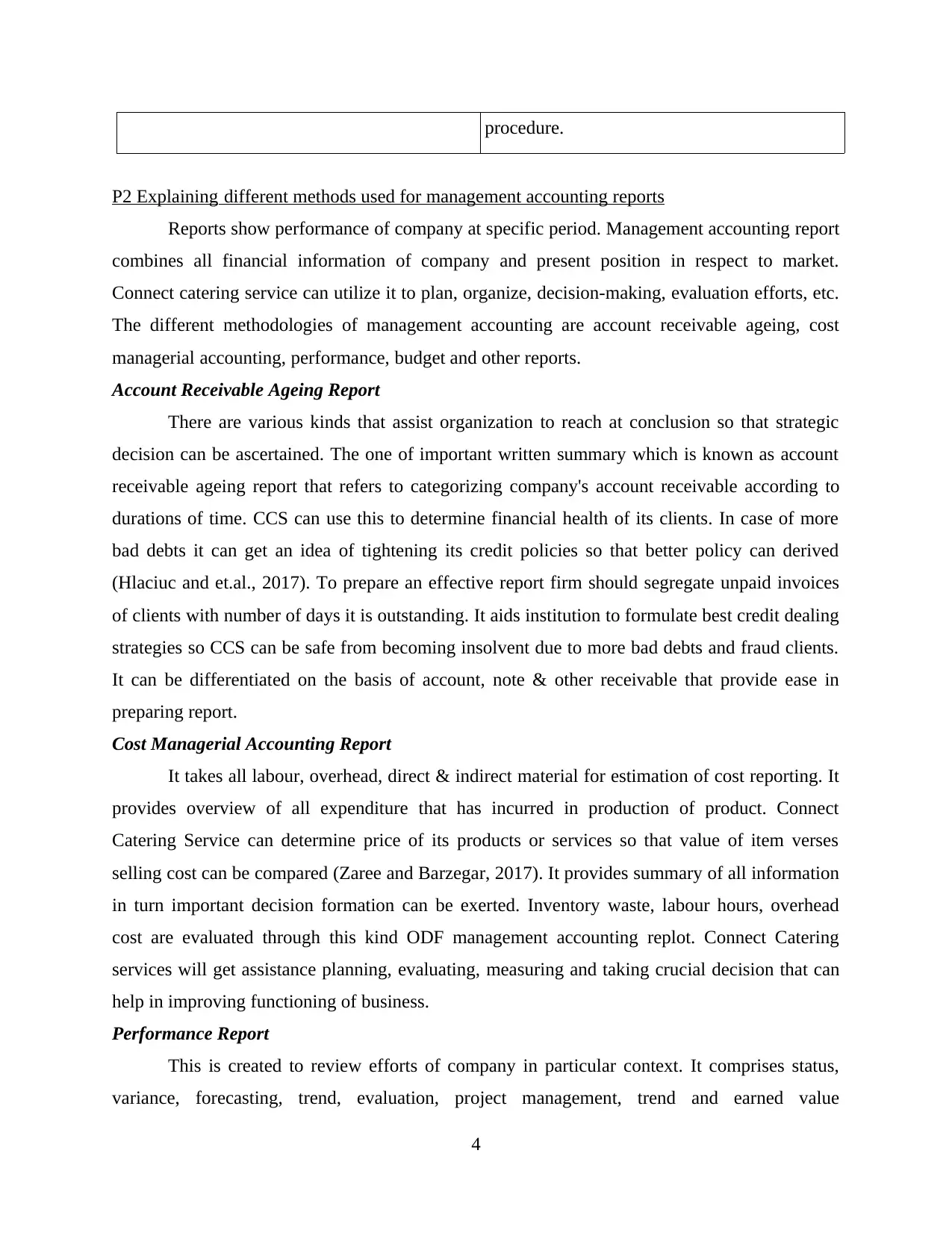
procedure.
P2 Explaining different methods used for management accounting reports
Reports show performance of company at specific period. Management accounting report
combines all financial information of company and present position in respect to market.
Connect catering service can utilize it to plan, organize, decision-making, evaluation efforts, etc.
The different methodologies of management accounting are account receivable ageing, cost
managerial accounting, performance, budget and other reports.
Account Receivable Ageing Report
There are various kinds that assist organization to reach at conclusion so that strategic
decision can be ascertained. The one of important written summary which is known as account
receivable ageing report that refers to categorizing company's account receivable according to
durations of time. CCS can use this to determine financial health of its clients. In case of more
bad debts it can get an idea of tightening its credit policies so that better policy can derived
(Hlaciuc and et.al., 2017). To prepare an effective report firm should segregate unpaid invoices
of clients with number of days it is outstanding. It aids institution to formulate best credit dealing
strategies so CCS can be safe from becoming insolvent due to more bad debts and fraud clients.
It can be differentiated on the basis of account, note & other receivable that provide ease in
preparing report.
Cost Managerial Accounting Report
It takes all labour, overhead, direct & indirect material for estimation of cost reporting. It
provides overview of all expenditure that has incurred in production of product. Connect
Catering Service can determine price of its products or services so that value of item verses
selling cost can be compared (Zaree and Barzegar, 2017). It provides summary of all information
in turn important decision formation can be exerted. Inventory waste, labour hours, overhead
cost are evaluated through this kind ODF management accounting replot. Connect Catering
services will get assistance planning, evaluating, measuring and taking crucial decision that can
help in improving functioning of business.
Performance Report
This is created to review efforts of company in particular context. It comprises status,
variance, forecasting, trend, evaluation, project management, trend and earned value
4
P2 Explaining different methods used for management accounting reports
Reports show performance of company at specific period. Management accounting report
combines all financial information of company and present position in respect to market.
Connect catering service can utilize it to plan, organize, decision-making, evaluation efforts, etc.
The different methodologies of management accounting are account receivable ageing, cost
managerial accounting, performance, budget and other reports.
Account Receivable Ageing Report
There are various kinds that assist organization to reach at conclusion so that strategic
decision can be ascertained. The one of important written summary which is known as account
receivable ageing report that refers to categorizing company's account receivable according to
durations of time. CCS can use this to determine financial health of its clients. In case of more
bad debts it can get an idea of tightening its credit policies so that better policy can derived
(Hlaciuc and et.al., 2017). To prepare an effective report firm should segregate unpaid invoices
of clients with number of days it is outstanding. It aids institution to formulate best credit dealing
strategies so CCS can be safe from becoming insolvent due to more bad debts and fraud clients.
It can be differentiated on the basis of account, note & other receivable that provide ease in
preparing report.
Cost Managerial Accounting Report
It takes all labour, overhead, direct & indirect material for estimation of cost reporting. It
provides overview of all expenditure that has incurred in production of product. Connect
Catering Service can determine price of its products or services so that value of item verses
selling cost can be compared (Zaree and Barzegar, 2017). It provides summary of all information
in turn important decision formation can be exerted. Inventory waste, labour hours, overhead
cost are evaluated through this kind ODF management accounting replot. Connect Catering
services will get assistance planning, evaluating, measuring and taking crucial decision that can
help in improving functioning of business.
Performance Report
This is created to review efforts of company in particular context. It comprises status,
variance, forecasting, trend, evaluation, project management, trend and earned value
4
⊘ This is a preview!⊘
Do you want full access?
Subscribe today to unlock all pages.

Trusted by 1+ million students worldwide
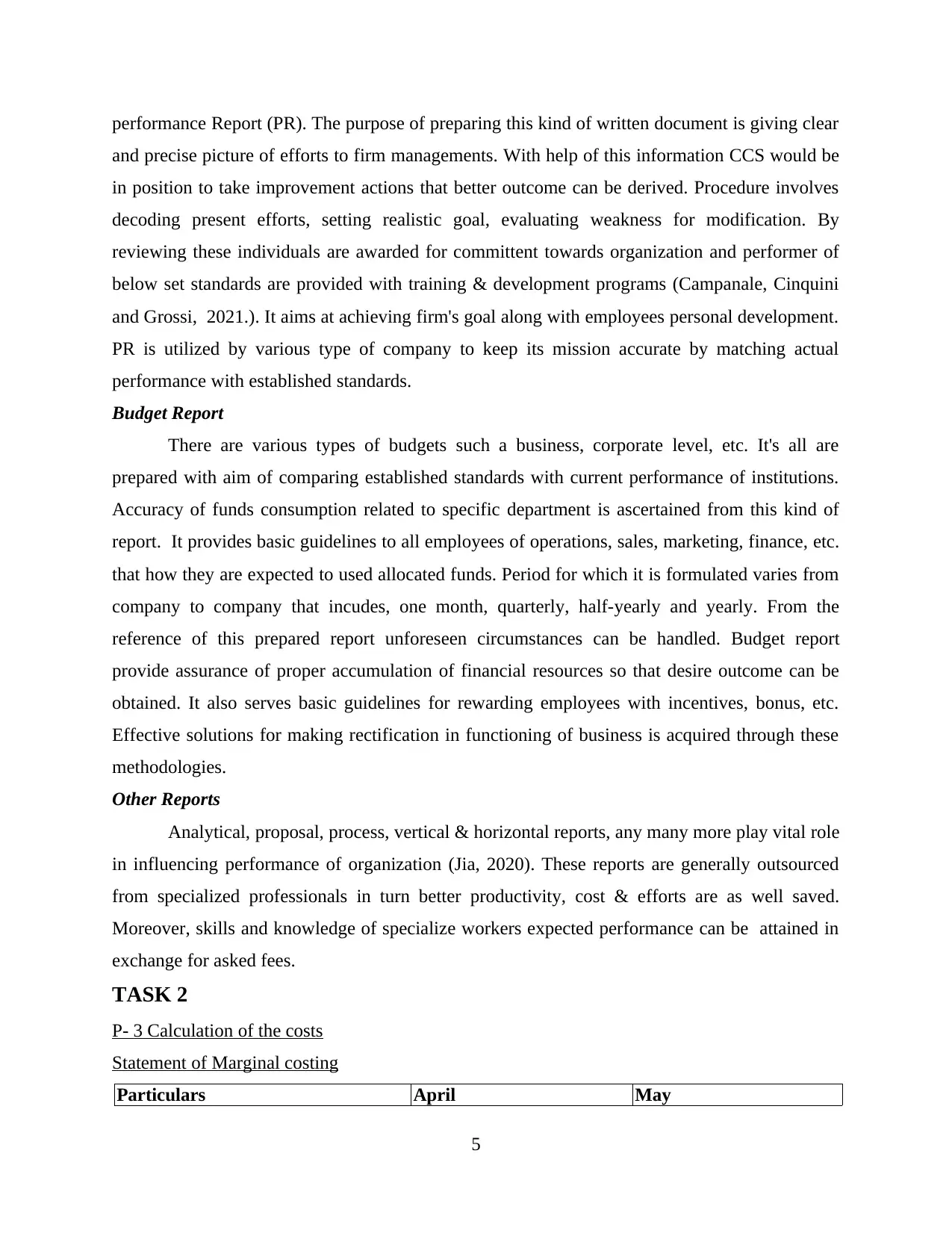
performance Report (PR). The purpose of preparing this kind of written document is giving clear
and precise picture of efforts to firm managements. With help of this information CCS would be
in position to take improvement actions that better outcome can be derived. Procedure involves
decoding present efforts, setting realistic goal, evaluating weakness for modification. By
reviewing these individuals are awarded for committent towards organization and performer of
below set standards are provided with training & development programs (Campanale, Cinquini
and Grossi, 2021.). It aims at achieving firm's goal along with employees personal development.
PR is utilized by various type of company to keep its mission accurate by matching actual
performance with established standards.
Budget Report
There are various types of budgets such a business, corporate level, etc. It's all are
prepared with aim of comparing established standards with current performance of institutions.
Accuracy of funds consumption related to specific department is ascertained from this kind of
report. It provides basic guidelines to all employees of operations, sales, marketing, finance, etc.
that how they are expected to used allocated funds. Period for which it is formulated varies from
company to company that incudes, one month, quarterly, half-yearly and yearly. From the
reference of this prepared report unforeseen circumstances can be handled. Budget report
provide assurance of proper accumulation of financial resources so that desire outcome can be
obtained. It also serves basic guidelines for rewarding employees with incentives, bonus, etc.
Effective solutions for making rectification in functioning of business is acquired through these
methodologies.
Other Reports
Analytical, proposal, process, vertical & horizontal reports, any many more play vital role
in influencing performance of organization (Jia, 2020). These reports are generally outsourced
from specialized professionals in turn better productivity, cost & efforts are as well saved.
Moreover, skills and knowledge of specialize workers expected performance can be attained in
exchange for asked fees.
TASK 2
P- 3 Calculation of the costs
Statement of Marginal costing
Particulars April May
5
and precise picture of efforts to firm managements. With help of this information CCS would be
in position to take improvement actions that better outcome can be derived. Procedure involves
decoding present efforts, setting realistic goal, evaluating weakness for modification. By
reviewing these individuals are awarded for committent towards organization and performer of
below set standards are provided with training & development programs (Campanale, Cinquini
and Grossi, 2021.). It aims at achieving firm's goal along with employees personal development.
PR is utilized by various type of company to keep its mission accurate by matching actual
performance with established standards.
Budget Report
There are various types of budgets such a business, corporate level, etc. It's all are
prepared with aim of comparing established standards with current performance of institutions.
Accuracy of funds consumption related to specific department is ascertained from this kind of
report. It provides basic guidelines to all employees of operations, sales, marketing, finance, etc.
that how they are expected to used allocated funds. Period for which it is formulated varies from
company to company that incudes, one month, quarterly, half-yearly and yearly. From the
reference of this prepared report unforeseen circumstances can be handled. Budget report
provide assurance of proper accumulation of financial resources so that desire outcome can be
obtained. It also serves basic guidelines for rewarding employees with incentives, bonus, etc.
Effective solutions for making rectification in functioning of business is acquired through these
methodologies.
Other Reports
Analytical, proposal, process, vertical & horizontal reports, any many more play vital role
in influencing performance of organization (Jia, 2020). These reports are generally outsourced
from specialized professionals in turn better productivity, cost & efforts are as well saved.
Moreover, skills and knowledge of specialize workers expected performance can be attained in
exchange for asked fees.
TASK 2
P- 3 Calculation of the costs
Statement of Marginal costing
Particulars April May
5
Paraphrase This Document
Need a fresh take? Get an instant paraphrase of this document with our AI Paraphraser
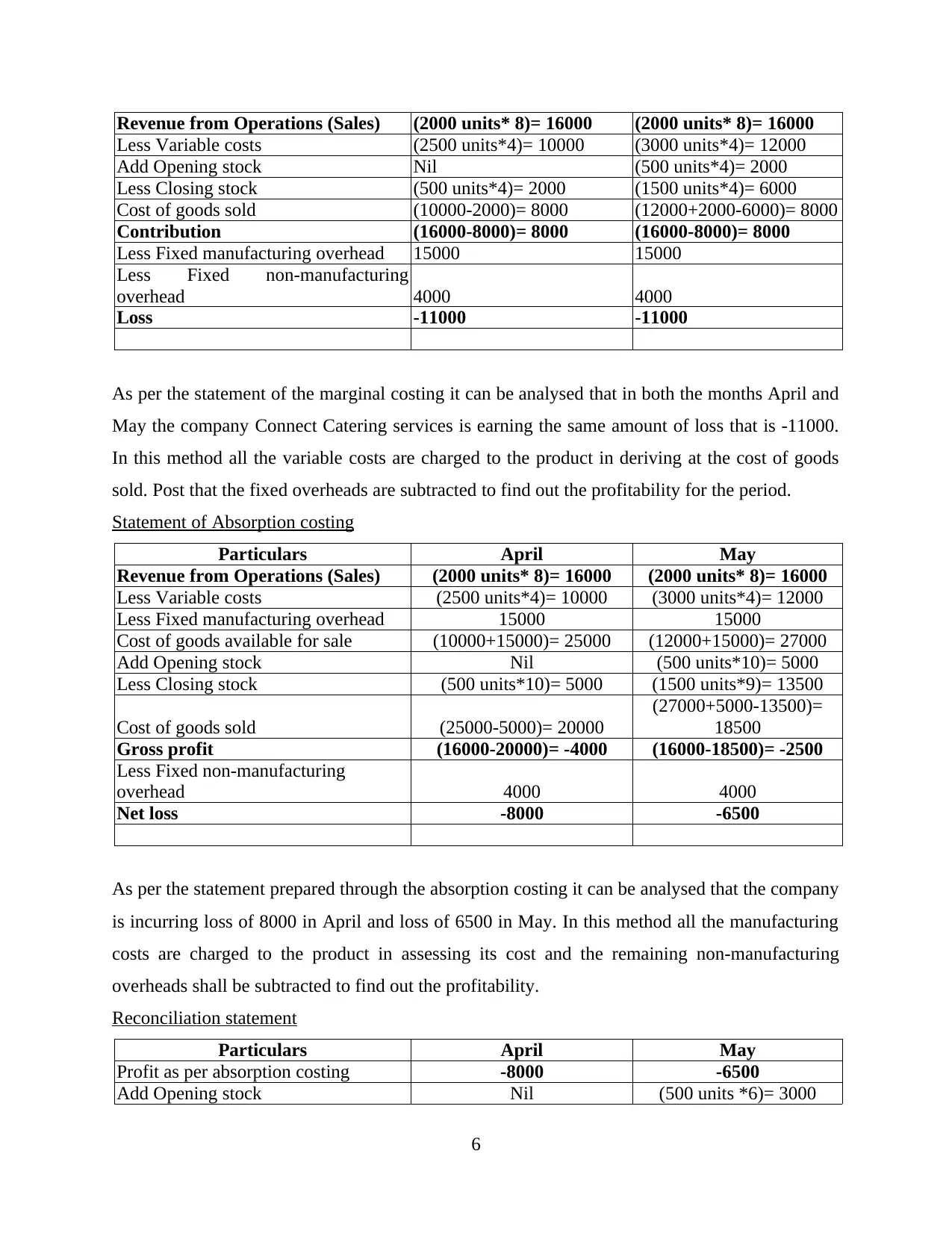
Revenue from Operations (Sales) (2000 units* 8)= 16000 (2000 units* 8)= 16000
Less Variable costs (2500 units*4)= 10000 (3000 units*4)= 12000
Add Opening stock Nil (500 units*4)= 2000
Less Closing stock (500 units*4)= 2000 (1500 units*4)= 6000
Cost of goods sold (10000-2000)= 8000 (12000+2000-6000)= 8000
Contribution (16000-8000)= 8000 (16000-8000)= 8000
Less Fixed manufacturing overhead 15000 15000
Less Fixed non-manufacturing
overhead 4000 4000
Loss -11000 -11000
As per the statement of the marginal costing it can be analysed that in both the months April and
May the company Connect Catering services is earning the same amount of loss that is -11000.
In this method all the variable costs are charged to the product in deriving at the cost of goods
sold. Post that the fixed overheads are subtracted to find out the profitability for the period.
Statement of Absorption costing
Particulars April May
Revenue from Operations (Sales) (2000 units* 8)= 16000 (2000 units* 8)= 16000
Less Variable costs (2500 units*4)= 10000 (3000 units*4)= 12000
Less Fixed manufacturing overhead 15000 15000
Cost of goods available for sale (10000+15000)= 25000 (12000+15000)= 27000
Add Opening stock Nil (500 units*10)= 5000
Less Closing stock (500 units*10)= 5000 (1500 units*9)= 13500
Cost of goods sold (25000-5000)= 20000
(27000+5000-13500)=
18500
Gross profit (16000-20000)= -4000 (16000-18500)= -2500
Less Fixed non-manufacturing
overhead 4000 4000
Net loss -8000 -6500
As per the statement prepared through the absorption costing it can be analysed that the company
is incurring loss of 8000 in April and loss of 6500 in May. In this method all the manufacturing
costs are charged to the product in assessing its cost and the remaining non-manufacturing
overheads shall be subtracted to find out the profitability.
Reconciliation statement
Particulars April May
Profit as per absorption costing -8000 -6500
Add Opening stock Nil (500 units *6)= 3000
6
Less Variable costs (2500 units*4)= 10000 (3000 units*4)= 12000
Add Opening stock Nil (500 units*4)= 2000
Less Closing stock (500 units*4)= 2000 (1500 units*4)= 6000
Cost of goods sold (10000-2000)= 8000 (12000+2000-6000)= 8000
Contribution (16000-8000)= 8000 (16000-8000)= 8000
Less Fixed manufacturing overhead 15000 15000
Less Fixed non-manufacturing
overhead 4000 4000
Loss -11000 -11000
As per the statement of the marginal costing it can be analysed that in both the months April and
May the company Connect Catering services is earning the same amount of loss that is -11000.
In this method all the variable costs are charged to the product in deriving at the cost of goods
sold. Post that the fixed overheads are subtracted to find out the profitability for the period.
Statement of Absorption costing
Particulars April May
Revenue from Operations (Sales) (2000 units* 8)= 16000 (2000 units* 8)= 16000
Less Variable costs (2500 units*4)= 10000 (3000 units*4)= 12000
Less Fixed manufacturing overhead 15000 15000
Cost of goods available for sale (10000+15000)= 25000 (12000+15000)= 27000
Add Opening stock Nil (500 units*10)= 5000
Less Closing stock (500 units*10)= 5000 (1500 units*9)= 13500
Cost of goods sold (25000-5000)= 20000
(27000+5000-13500)=
18500
Gross profit (16000-20000)= -4000 (16000-18500)= -2500
Less Fixed non-manufacturing
overhead 4000 4000
Net loss -8000 -6500
As per the statement prepared through the absorption costing it can be analysed that the company
is incurring loss of 8000 in April and loss of 6500 in May. In this method all the manufacturing
costs are charged to the product in assessing its cost and the remaining non-manufacturing
overheads shall be subtracted to find out the profitability.
Reconciliation statement
Particulars April May
Profit as per absorption costing -8000 -6500
Add Opening stock Nil (500 units *6)= 3000
6
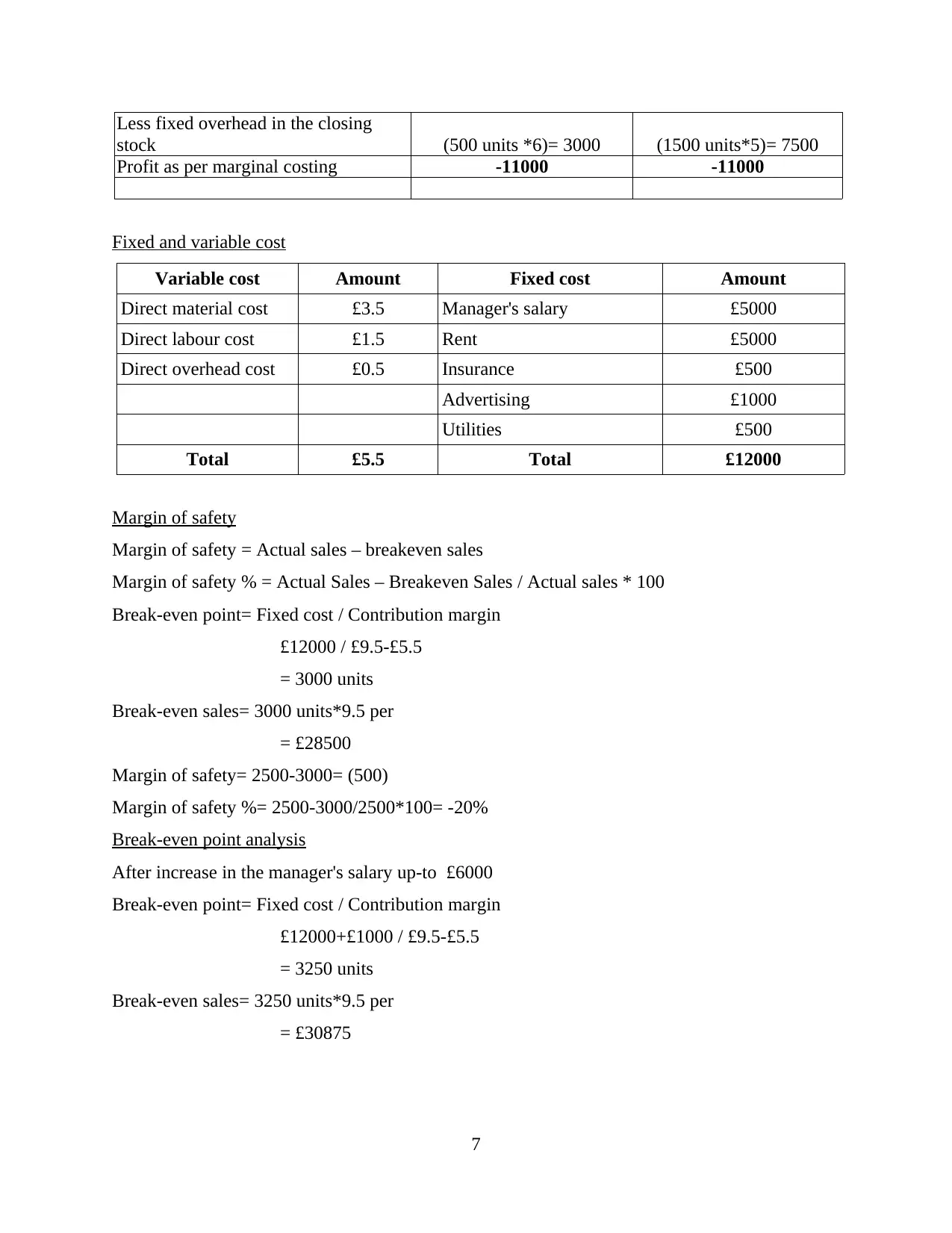
Less fixed overhead in the closing
stock (500 units *6)= 3000 (1500 units*5)= 7500
Profit as per marginal costing -11000 -11000
Fixed and variable cost
Variable cost Amount Fixed cost Amount
Direct material cost £3.5 Manager's salary £5000
Direct labour cost £1.5 Rent £5000
Direct overhead cost £0.5 Insurance £500
Advertising £1000
Utilities £500
Total £5.5 Total £12000
Margin of safety
Margin of safety = Actual sales – breakeven sales
Margin of safety % = Actual Sales – Breakeven Sales / Actual sales * 100
Break-even point= Fixed cost / Contribution margin
£12000 / £9.5-£5.5
= 3000 units
Break-even sales= 3000 units*9.5 per
= £28500
Margin of safety= 2500-3000= (500)
Margin of safety %= 2500-3000/2500*100= -20%
Break-even point analysis
After increase in the manager's salary up-to £6000
Break-even point= Fixed cost / Contribution margin
£12000+£1000 / £9.5-£5.5
= 3250 units
Break-even sales= 3250 units*9.5 per
= £30875
7
stock (500 units *6)= 3000 (1500 units*5)= 7500
Profit as per marginal costing -11000 -11000
Fixed and variable cost
Variable cost Amount Fixed cost Amount
Direct material cost £3.5 Manager's salary £5000
Direct labour cost £1.5 Rent £5000
Direct overhead cost £0.5 Insurance £500
Advertising £1000
Utilities £500
Total £5.5 Total £12000
Margin of safety
Margin of safety = Actual sales – breakeven sales
Margin of safety % = Actual Sales – Breakeven Sales / Actual sales * 100
Break-even point= Fixed cost / Contribution margin
£12000 / £9.5-£5.5
= 3000 units
Break-even sales= 3000 units*9.5 per
= £28500
Margin of safety= 2500-3000= (500)
Margin of safety %= 2500-3000/2500*100= -20%
Break-even point analysis
After increase in the manager's salary up-to £6000
Break-even point= Fixed cost / Contribution margin
£12000+£1000 / £9.5-£5.5
= 3250 units
Break-even sales= 3250 units*9.5 per
= £30875
7
⊘ This is a preview!⊘
Do you want full access?
Subscribe today to unlock all pages.

Trusted by 1+ million students worldwide
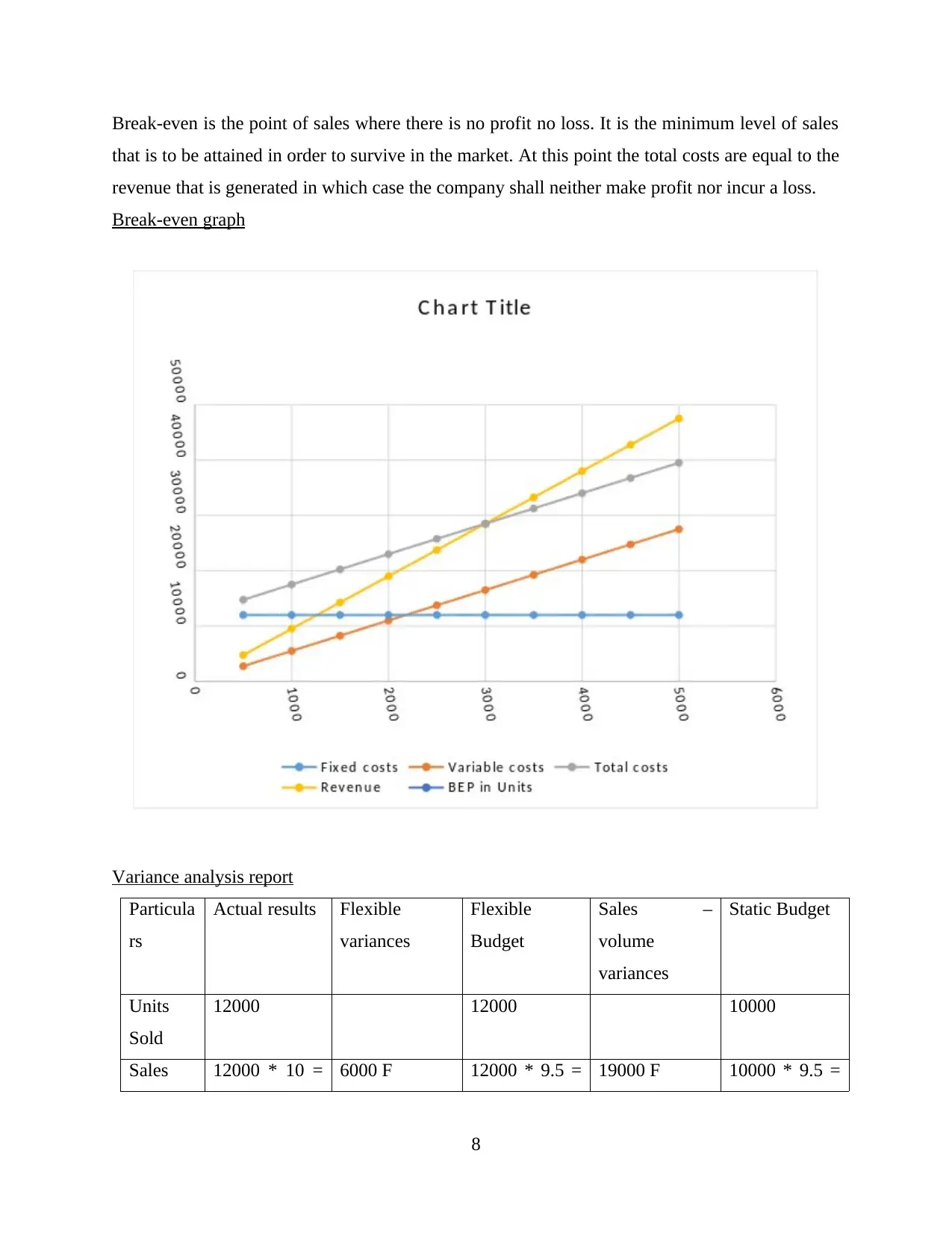
Break-even is the point of sales where there is no profit no loss. It is the minimum level of sales
that is to be attained in order to survive in the market. At this point the total costs are equal to the
revenue that is generated in which case the company shall neither make profit nor incur a loss.
Break-even graph
Variance analysis report
Particula
rs
Actual results Flexible
variances
Flexible
Budget
Sales –
volume
variances
Static Budget
Units
Sold
12000 12000 10000
Sales 12000 * 10 = 6000 F 12000 * 9.5 = 19000 F 10000 * 9.5 =
8
that is to be attained in order to survive in the market. At this point the total costs are equal to the
revenue that is generated in which case the company shall neither make profit nor incur a loss.
Break-even graph
Variance analysis report
Particula
rs
Actual results Flexible
variances
Flexible
Budget
Sales –
volume
variances
Static Budget
Units
Sold
12000 12000 10000
Sales 12000 * 10 = 6000 F 12000 * 9.5 = 19000 F 10000 * 9.5 =
8
Paraphrase This Document
Need a fresh take? Get an instant paraphrase of this document with our AI Paraphraser
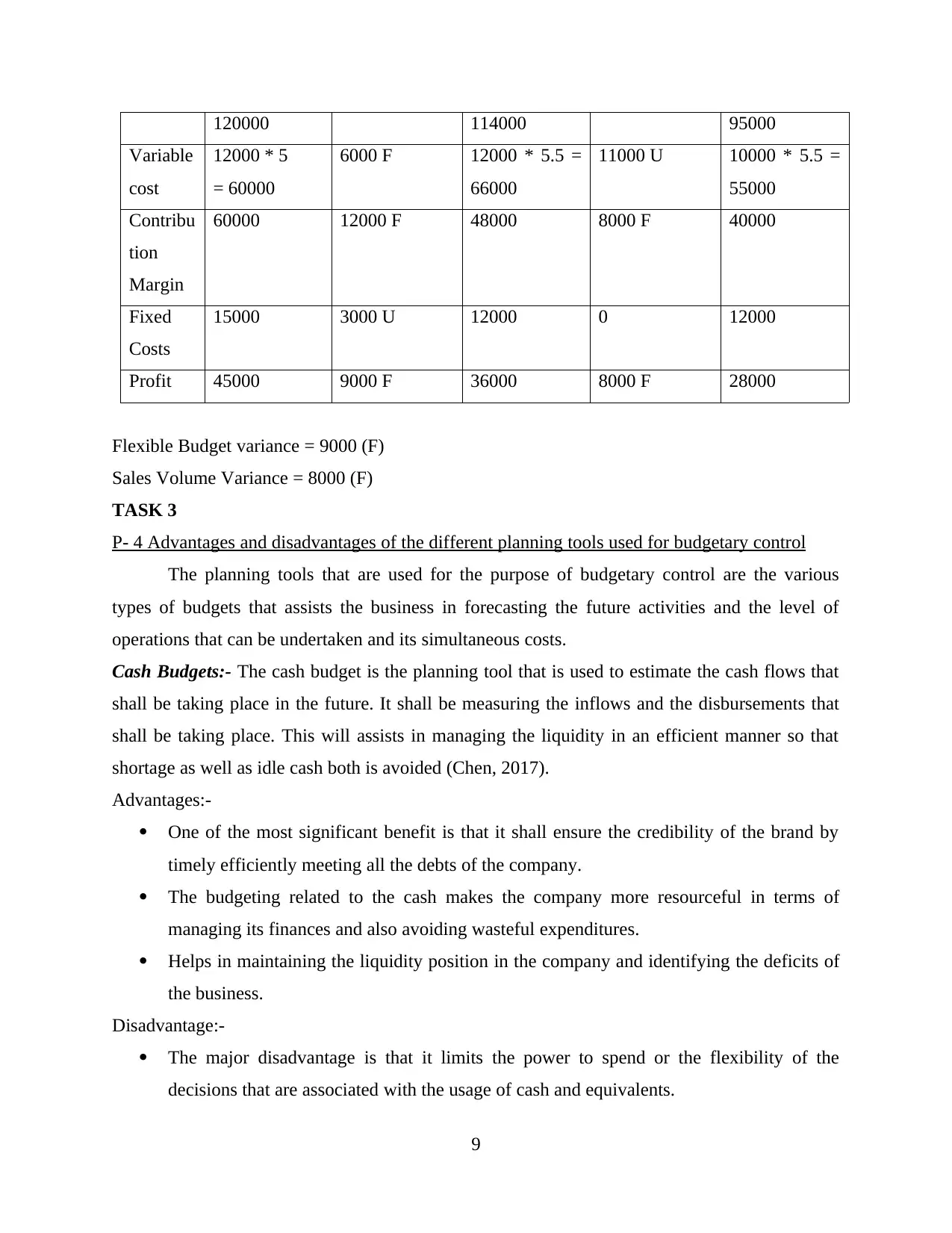
120000 114000 95000
Variable
cost
12000 * 5
= 60000
6000 F 12000 * 5.5 =
66000
11000 U 10000 * 5.5 =
55000
Contribu
tion
Margin
60000 12000 F 48000 8000 F 40000
Fixed
Costs
15000 3000 U 12000 0 12000
Profit 45000 9000 F 36000 8000 F 28000
Flexible Budget variance = 9000 (F)
Sales Volume Variance = 8000 (F)
TASK 3
P- 4 Advantages and disadvantages of the different planning tools used for budgetary control
The planning tools that are used for the purpose of budgetary control are the various
types of budgets that assists the business in forecasting the future activities and the level of
operations that can be undertaken and its simultaneous costs.
Cash Budgets:- The cash budget is the planning tool that is used to estimate the cash flows that
shall be taking place in the future. It shall be measuring the inflows and the disbursements that
shall be taking place. This will assists in managing the liquidity in an efficient manner so that
shortage as well as idle cash both is avoided (Chen, 2017).
Advantages:-
One of the most significant benefit is that it shall ensure the credibility of the brand by
timely efficiently meeting all the debts of the company.
The budgeting related to the cash makes the company more resourceful in terms of
managing its finances and also avoiding wasteful expenditures.
Helps in maintaining the liquidity position in the company and identifying the deficits of
the business.
Disadvantage:-
The major disadvantage is that it limits the power to spend or the flexibility of the
decisions that are associated with the usage of cash and equivalents.
9
Variable
cost
12000 * 5
= 60000
6000 F 12000 * 5.5 =
66000
11000 U 10000 * 5.5 =
55000
Contribu
tion
Margin
60000 12000 F 48000 8000 F 40000
Fixed
Costs
15000 3000 U 12000 0 12000
Profit 45000 9000 F 36000 8000 F 28000
Flexible Budget variance = 9000 (F)
Sales Volume Variance = 8000 (F)
TASK 3
P- 4 Advantages and disadvantages of the different planning tools used for budgetary control
The planning tools that are used for the purpose of budgetary control are the various
types of budgets that assists the business in forecasting the future activities and the level of
operations that can be undertaken and its simultaneous costs.
Cash Budgets:- The cash budget is the planning tool that is used to estimate the cash flows that
shall be taking place in the future. It shall be measuring the inflows and the disbursements that
shall be taking place. This will assists in managing the liquidity in an efficient manner so that
shortage as well as idle cash both is avoided (Chen, 2017).
Advantages:-
One of the most significant benefit is that it shall ensure the credibility of the brand by
timely efficiently meeting all the debts of the company.
The budgeting related to the cash makes the company more resourceful in terms of
managing its finances and also avoiding wasteful expenditures.
Helps in maintaining the liquidity position in the company and identifying the deficits of
the business.
Disadvantage:-
The major disadvantage is that it limits the power to spend or the flexibility of the
decisions that are associated with the usage of cash and equivalents.
9
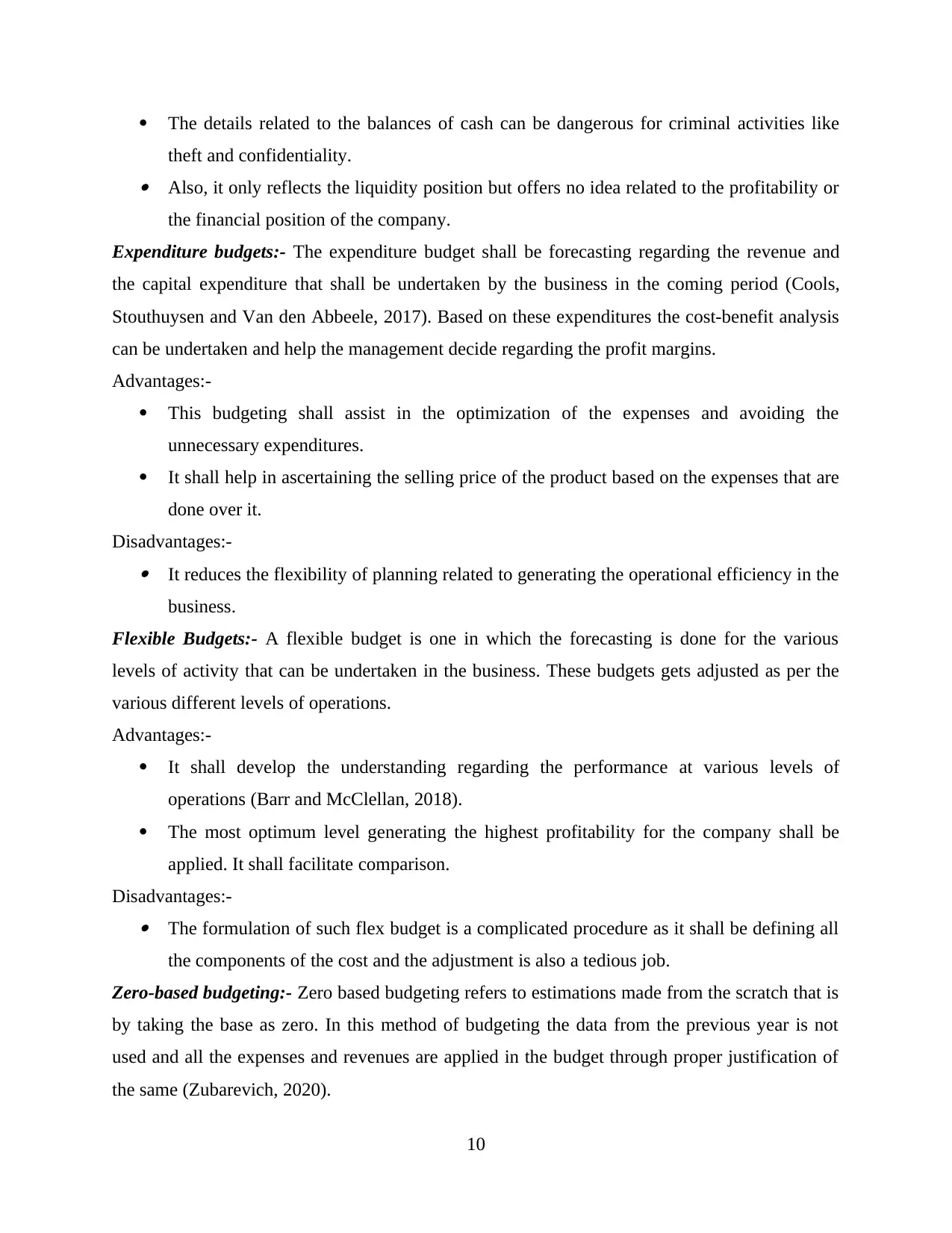
The details related to the balances of cash can be dangerous for criminal activities like
theft and confidentiality. Also, it only reflects the liquidity position but offers no idea related to the profitability or
the financial position of the company.
Expenditure budgets:- The expenditure budget shall be forecasting regarding the revenue and
the capital expenditure that shall be undertaken by the business in the coming period (Cools,
Stouthuysen and Van den Abbeele, 2017). Based on these expenditures the cost-benefit analysis
can be undertaken and help the management decide regarding the profit margins.
Advantages:-
This budgeting shall assist in the optimization of the expenses and avoiding the
unnecessary expenditures.
It shall help in ascertaining the selling price of the product based on the expenses that are
done over it.
Disadvantages:- It reduces the flexibility of planning related to generating the operational efficiency in the
business.
Flexible Budgets:- A flexible budget is one in which the forecasting is done for the various
levels of activity that can be undertaken in the business. These budgets gets adjusted as per the
various different levels of operations.
Advantages:-
It shall develop the understanding regarding the performance at various levels of
operations (Barr and McClellan, 2018).
The most optimum level generating the highest profitability for the company shall be
applied. It shall facilitate comparison.
Disadvantages:- The formulation of such flex budget is a complicated procedure as it shall be defining all
the components of the cost and the adjustment is also a tedious job.
Zero-based budgeting:- Zero based budgeting refers to estimations made from the scratch that is
by taking the base as zero. In this method of budgeting the data from the previous year is not
used and all the expenses and revenues are applied in the budget through proper justification of
the same (Zubarevich, 2020).
10
theft and confidentiality. Also, it only reflects the liquidity position but offers no idea related to the profitability or
the financial position of the company.
Expenditure budgets:- The expenditure budget shall be forecasting regarding the revenue and
the capital expenditure that shall be undertaken by the business in the coming period (Cools,
Stouthuysen and Van den Abbeele, 2017). Based on these expenditures the cost-benefit analysis
can be undertaken and help the management decide regarding the profit margins.
Advantages:-
This budgeting shall assist in the optimization of the expenses and avoiding the
unnecessary expenditures.
It shall help in ascertaining the selling price of the product based on the expenses that are
done over it.
Disadvantages:- It reduces the flexibility of planning related to generating the operational efficiency in the
business.
Flexible Budgets:- A flexible budget is one in which the forecasting is done for the various
levels of activity that can be undertaken in the business. These budgets gets adjusted as per the
various different levels of operations.
Advantages:-
It shall develop the understanding regarding the performance at various levels of
operations (Barr and McClellan, 2018).
The most optimum level generating the highest profitability for the company shall be
applied. It shall facilitate comparison.
Disadvantages:- The formulation of such flex budget is a complicated procedure as it shall be defining all
the components of the cost and the adjustment is also a tedious job.
Zero-based budgeting:- Zero based budgeting refers to estimations made from the scratch that is
by taking the base as zero. In this method of budgeting the data from the previous year is not
used and all the expenses and revenues are applied in the budget through proper justification of
the same (Zubarevich, 2020).
10
⊘ This is a preview!⊘
Do you want full access?
Subscribe today to unlock all pages.

Trusted by 1+ million students worldwide
1 out of 16
Related Documents
Your All-in-One AI-Powered Toolkit for Academic Success.
+13062052269
info@desklib.com
Available 24*7 on WhatsApp / Email
![[object Object]](/_next/static/media/star-bottom.7253800d.svg)
Unlock your academic potential
Copyright © 2020–2025 A2Z Services. All Rights Reserved. Developed and managed by ZUCOL.





